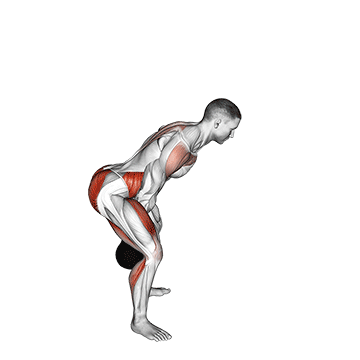Exercise details
- Target muscle: Gluteus Maximus
- Synergists: Hamstrings, Adductor Magnus, Soleus, Quadriceps (Rectus Femoris, Vastus Lateralis, Vastus Medialis, Vastus Intermedius), Erector Spinae, Middle and Lower Trapezius, Anterior Deltoid, Lateral Deltoid, Clavicular (Upper) Pectoralis Major, Serratus Anterior
- Mechanics: Compound
- Force: Pull
Starting position
- Stand with your legs a little wider than shoulder width apart, with a kettlebell between your feet.
- Hinge at the hips and a little at the knees, grasp the kettlebell with both hands, and lift it a little off the floor by extending your hips. At this point, your back and arms should be straight, your torso should be almost horizontal, your knees should be slightly flexed, and the kettlebell should be hanging straight down in front of you.
Execution
- Inhale as you slowly swing the kettlebell backward and up between your legs.
- As the kettlebell starts to swing forward, forcefully extend your hips and knees to swing the kettlebell up in front of you. At the top of the movement, squeeze your glutes.
- As the kettlebell swings back down, hinge at the hips and a little at the knees and guide the kettlebell between your legs.
- Repeat the forward and backward swings for the prescribed number of times.
Comments and tips
- Do not swing the kettlebell too high; stop when your arms are parallel with the floor.
- Keep your head up, your core tight, your back straight, your feet flat, and your feet and knees pointing in the same direction.
- The abs and obliques only act as stabilizers, which is why they have not been labeled.
- The kettlebell swing exercise is not a combination of a shallow squat followed by a front raise. It’s more like a plyometric stiff-leg deadlift. Nearly all of the movement should be in your hips and shoulders. What’s more, the momentum for the forward swing of the kettlebell should come from the extension of your hips and not from the flexion of your shoulders.
- The kettlebell swing can be used in cardio circuits and to strengthen your posterior chain muscles (erector spinae, gluteus maximus, adductor magnus, hamstrings, and soleus). Since the posterior chain is responsible for forward propulsion, exercises that strengthen the chain, such as the kettlebell swing, are useful for developing functional strength, as well as improving gait and sporting performance.
- Make the kettlebell swing more difficult by holding a kettlebell in each hand. See second video.
















